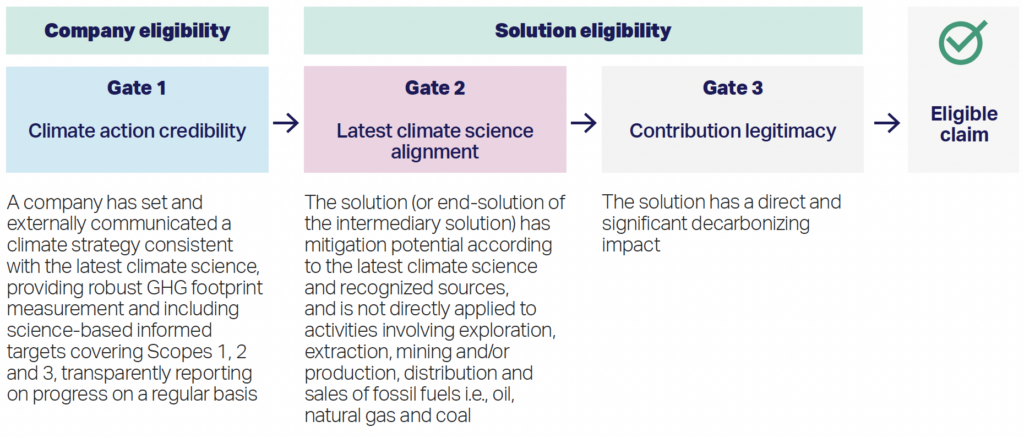Great Opportunities and Great Responsibilities
An extract of the „Guidance On Avoided Emissions“ by the World Business Council of Sustanable Development (WBCSD)
Societies must drastically cut emissions and protect and develop carbon sinks to limit the rise of the global temperature to no more than 1.5°C above pre-industrial levels and to achieve a state of Net Zero Greenhouse Gas (GHG) emissions by the middle of the century.
European Commission’s Corporate Reporting Sustainability Directive (CSRD), which now requires companies to disclose their 1.5°C aligned transition plans besides other requirements. However, if companies are only encouraged to reduce inventory emissions, instead of also transforming into low- and zero-emissions solution providers, the shared goal of achieving global Net Zero by 2050 will fall out of reach.
WBCSD now defines three different indicators to be monitored. Besides carbon footprint and carbon removal these are the avoided emissions. But what are avoided emissions? Company contributions to global mitigation should not be limited to reducing their own and value chain GHG emissions but should also strive to accelerate global decarbonization efforts by delivering additional solutions that are compatible with a 1.5°C pathway and enabling others to reduce emissions as well. Companies need to go beyond the act of reducing emissions. This broader contribution of companies to the global Net Zero target has been defined as Avoided Emissions. In detail, avoided emissions refer to the positive impact to society when comparing the GHG emissions of a solution to an alternative reference scenario where the solution would not have been used. Nevertheless, the avoided emissions alone would also not lead to a Net Zero situation.
Companies and relevant stakeholders need to be inspired focussing on their roles in the promotion of system-wide changes. The guidance will support this kind of transformation and scaling of low-carbon solutions and markets leading to a fast-track decarbonization of society. The focus is on avoided emissions solely generated through the introduction of solutions (e.g., products, services, technology, projects) within the supply chain, thus upstream and downstream. At the same time, it has been recognized by WBCSD that consistency and credibility are needed related to claims made by companies and a guidance can help here.
Leveraging avoided emissions
There are three ways to leverage avoided emissions: use avoided emissions as a guiding metric to support innovation processes, use avoided emissions as a key decision metric to prioritize in markets and portfolio choices, and use avoided emissions to increase accountability of companies by demonstrating and tracking its own contributions to a 1.5°C-aligned society. Focus is here not only on businesses but also on investors, society and governments.

Ensuring the eligibility
A three step approach has been defined to limit misuse of avoided emissions. A company has to communicate a climate strategy consistent with the latest climate science providing robust GHG footprint measurement and including science-based targets, the solution of a company has mitigation potential and the solution has a direct and significant decarbonizing impact.

Quantifying avoided emissions
The assessment of avoided emissions need to cover the timeframe, to define reference scenario, to assess solution and reference scenario, to assess avoided emissions. The reference scenario is model-based, fictional and thus not verifiable per se. The assessment of avoided emissions need to take into consideration the solution’s entire life cycle.

Communicating and reporting
A variety of requirements are defined e.g. no communication together with GHG inventory nor carbon sinks, or no usage of avoided emissions to reach carbon neutrality. In addition, the share of revenues generated by avoided emissions needs be communicated.
A variety of alternative terms, namely “Handprint,” “Enablement,” or “Scope 4.“ is available but either misleading or not as conclusive. Therefore, WBCSD has designed and supports this guidance on avoided emissions pursuing high integrity, less greenwashing and more decarbonization while at the same time the topic of how to quantify avoided emissions needs even more guidance.
How DFGE can support you
DFGE can help you to calculate and reduce your emissions and to transform your business into low- and zero-emissions solution provider. We support you to go beyond the act of reducing emissions and to reach the requirements set by the Corporate Reporting Sustainability Directive (CSRD). Check out our solutions, contact us via or at +49 8192-99733-20.
Source: Guidance On Avoided Emissions by the World Business Council of Sustanable Development (WBCSD)









